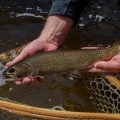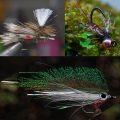How to Tie an Atherton #2 Medium Color Nymph
Producer: Tim Flagler
This fly is a true classic. It’s John Atherton’s Atherton #2 or Medium Color Nymph. Mr. Atherton was an amazing, impressionistic tier but not especially clever when it came to naming his creations.
For a hook, I’m going modern with a barbless, Fulling Mill 35085 in size 14. Begin by getting the hook firmly secured in the jaws of your tying vise.
For thread, I’ve loaded a bobbin with a spool of UTC 70 Denier in tan. Get your thread started on the hook shank leaving some space behind the eye and take a few wraps rearward before snipping off the tag.
This is going to seem a bit weird but I like to do the initial tie-in of the Hungarian Partridge hackle collar at this point, as it allows me to use feathers that have slightly longer fibers. To prep the feather, strip off all the lower, fuzzy fibers. Preen down a few of the remaining lower fibers on the stem and hold a shank-length out beyond the back edge of the hook eye. Take note of where the stem crosses the hook shank. Wrap your tying thread back to that point, then measure again. When the length of the fibers is correct, stop wrapping. Get hold of the feather by its very tip and gently preen down the lower fibers to expose that tip. Then, snip it off to form a small triangular tie-in anchor.
Lay the anchor against the near side of the hook and take thread wraps forward to secure it. Reach for your favorite hackle pliers and use them to get hold of the feather’s stem then gently preen the fibers rearward. Take wraps with the feather to build up a sparse collar on the fly. When you reach your tying thread, use it to anchor the stem then snip the excess off close. You should be left with a beautiful collar at a completely wrong place on the fly. To remedy this, sweep all the fibers forward, out over the hook eye and hold them there. Take wraps of tying thread to bind them down behind the eye then continue taking thread wraps rearward, almost to the hook point. Ideally, the Hungarian Partridge fibers should be spread evenly around the hook shank.
Natural pheasant tail fibers are used for the tail of the fly. Pull down just 3 fibers perpendicular to the feather’s stem and strip them free. While keeping the tips aligned, measure to form a tail about a hook shank in length then reach in with your tying scissors and snip the butt ends off, even with the back edge of the collar tie-in clump. Pulling up on the fibers as you go, take thread wraps rearward to anchor them to the top of the hook shank all the way back to the start of the bend.
Small, oval gold French tinsel is used to rib and segment the fly. A 6” length is enough for a couple of #2’s. Secure one end of the tinsel to the far side of the hook at the base of the tail. Take thread wraps forward, binding the material down as you go. End with your tying thread at about the hook point.
Natural hare’s mask dubbing is used for both the abdomen and thorax of the fly. Pull a small pinch free from the packet and use it to create a slender 2” long dubbing noodle on your tying thread. Start taking wraps with the noodle so the dubbing begins right at the base of the tail. Then take touching wraps forward to build up a lightly tapered abdomen on the fly that extends to about the 2/3rds point on the hook shank.
Get hold of the gold tinsel and start making open spiral wraps with it to rib and segment the body of the fly. When you reach your tying thread, use it to anchor the tinsel then snip the excess off close.
The original pattern lists European Kingfisher for the wing case but I’ve long believed the Kingfisher to be my spirit animal, so using it here would not be cool. Instead, I pull down a couple dozen or so Silver Doctor blue, webby saddle hackle fibers and strip them free from the stem. I then orient the clump, so the tips point to the right and flatten it out a bit. You can then trim them off square. Place the fibers on top of the hook shank and secure them with wraps of tying thread. If you can get the fibers to spread out a little bit, on top of the fly, so much the better.
Grab another small pinch of the same dubbing as before and this time create only an inch-long, slender noodle on your tying thread. With the dubbing beginning right at the back edge of the wing case, start taking wraps with the noodle to build up an ample thorax on the fly. End with your tying thread a full eye-length behind the back edge of the hook eye.
Pull the wing case forward, out over the front of the fly and bind it down with a few tight turns of tying thread. Again, try to maintain some space between your tying thread and the back edge of the hook eye. Pull the butt ends of the wing case material up and snip them off close.
Reach for a half-hitch tool or a bodkin with a small hole in the end and use it to push back and distribute the Hungarian partridge fibers rearward, then hold them back with the fingertips of your left hand. This may take several tries to get everything held back. Take wraps of tying thread to pin the fibers rearward in a swept-back position, like so.
Resist the urge to take a whole bunch of thread wraps. Instead, get hold of your whip finish tool and use it, right then and there, to do a 5 or 6 turn whip finish, seat the knot well and snip or cut your tying thread free.
A fine-tipped bodkin works well and is the traditional tool for roughing up the body of the fly to give it a buggy look. A drop of head cement, here Sally Hansen Hard as Nails, applied to the somewhat delicate wing case and the head of the fly will help to increase its durability.
There’s a whole lot of goodness wrapped up in this one little pattern, including what we’d call today a bright blue hot spot.
How to Tie an Antron Egg
How to Tie an Ausable Wulff











